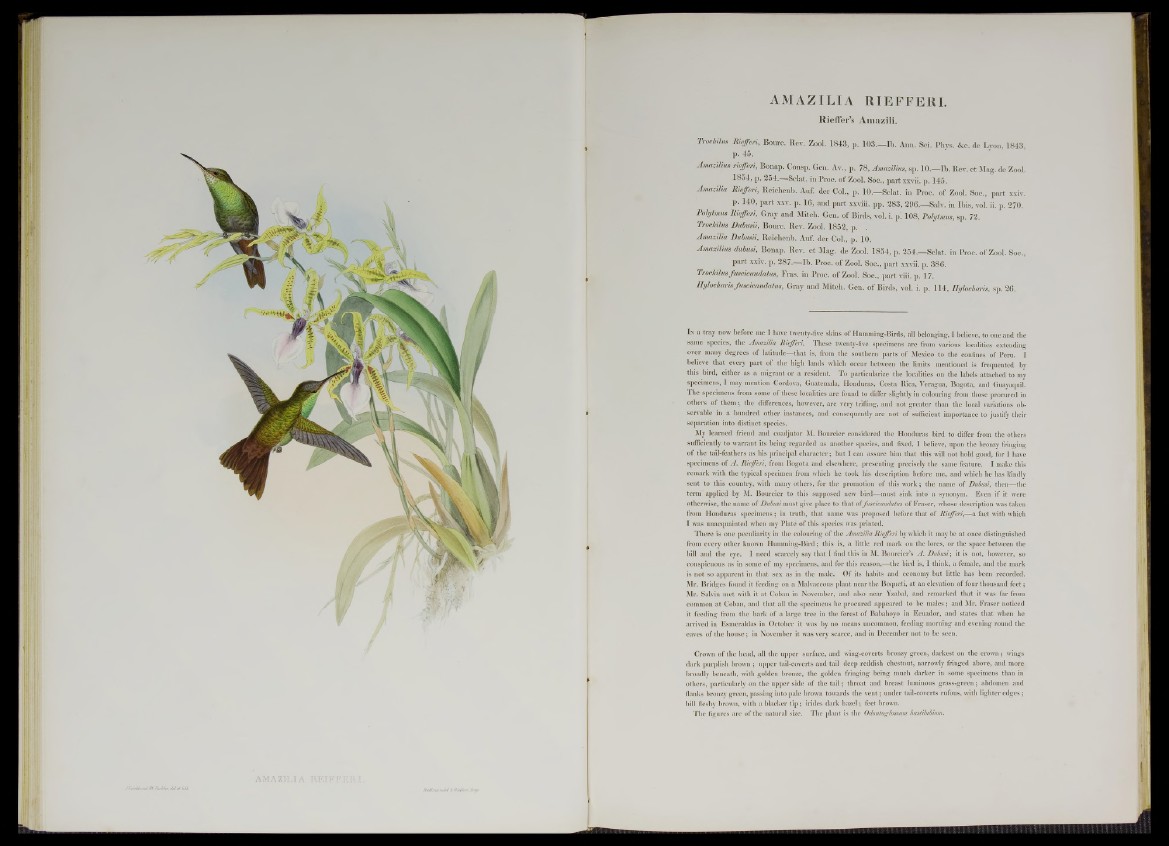
AMAH
AMAZILIA RIEFFERI.
liieffer’s Amazili.
Troehilm Riefferi, Bourc. Rev. Zool. 1843, p. 103.— Ib. Ann. Sci. Phys. &c. de Lyon, 1843,
p. 45.
Amazilius riefferi, Bonap. Consp. Gen. Av., p. 78, Amrmlim, sp. 10.— Ib. Bev. e t Mag. de Zool.
1854, p. 254.— Sclat. inP ro e . o f Zool. Soc., p a rt xxvii. p. 145.
Amazilia Riefferi, Reichenb. Auf. der Col., p . 10— Sclat. in Proc. o f Zool. Soc., p a rt xxiv.
p. 140, p a rt xxv. p. 16, and p a rt xxviii. pp. 283, 296.—Salv. in Ibis, vol. ii. p. 270.
Poh/tmus Riefferi, Gray and Mitcb. Gen. of Birds, vol. i. p! 108, Polytmm, sp. 72.
Troehilm Bubusii, Bourc. Rev. Zool. 1852, p.
Amazilia Bubusii, Reichenb. Auf. der Col., p. 10.
Amariliws dufmri, Bonap. Bev. e t Mag. de Zool. 1854, p. 254— Sclat. in Proc. of Zool. Soc.,
p a rt xxiv. p. 287.— Ib . Proc. o f Zool. Soc., p a rt xxvii. p. 386.
Troehilm fm cica u d a tm , Fras. in Proc. o f Zool. Soc., p a rt viii. p. 17.
Hylocharis fm c ica u d a tm , Gray and Mitch. Gen. o f Birds, vol. i. p. 114, Hylocharis, sp. 26.
In a tray now before me I have tweuty-five skins of Humming-Birds, all belonging, I believe, to one and the
same species, the Amazilia Riefferi. These twenty-five specimens are from various localities extending
over many degrees of latitude—that is, from the southern parts of Mexico to the confines of Peru. I
believe that every part of the high lands which occur between the limits mentioned is frequented by
this bird, either as a migrant or a resident. To particularize the localities on the labels attached to my
specimens, I may mention Cordova, Guatemala, Honduras, Costa Rica, Veragua, Bogota, and Guayaquil.
The specimens from some of these localities are found to differ slightly in colouring from those procured in
others of them; the differences, however, are very trilling, and not greater than the local variations observable
in a hundred other instances, and consequently are not of sufficient importance to justify their
separation into distinct species.
My learned friend and coadjutor M. Bourcier considered the Honduras bird to differ from the others
sufficiently to warrant its being regarded as another species, and fixed, I believe, upon the bronzy fringing
of the tail-feathers as his principal character; but I can assure him that this will not hold good, for I have
specimens of A. Riefferi, from Bogota and elsewhere, presenting precisely the same feature. I make this
remark with the typical specimen from which he took his description before me, and which he has kindly
sent to this country, with many others, for the promotion of this work; the name of Bubusi, then—the
term applied by M. Bourcier to this supposed new bird—must sink into a synonym. Even if it were
otherwise, the name of Bubusi must give place to that offuscicaudatus of Fraser, whose description was taken
from Honduras specimens; in truth, that name was proposed before that of Riefferi,—a fact with which
I was unacquainted when my Plate of this species was printed.
There is one peculiarity in the colouring of the Amazilia Riefferi by which it may be at once distinguished
from every other known Humming-Bird; this is, a little red mark on the lores, or the space between the
bill and the eye. I need scarcely say that I find this in M. Bourcier’s A. Bubusi; it is not, however, so
conspicuous as in some of my specimens, and for this reason,— the bird is, I think, a female, and the mark
is not so apparent in that sex as in the male. Of its habits and economy but little has been recorded.
Mr. Bridges found it feeding on a Malvaceous plant near the Boqueti, at an elevation of four thousand feet;
Mr. Salvin met with it at Coban in November, and also near Yzabal, and remarked that it was far from
common at Coban, and that all the specimens he procured appeared to be males; and Mr. Fraser noticed
it feeding from the bark of a large tree in the forest of Babahoyo in Ecuador, and states that when he
arrived in Esmeraldas in October it was by no means uncommon, feeding morning and evening round the
eaves of the house; in November it was very scarce, and in December not to be seen.
Crown of the head, all the upper surface, and wing-coverts bronzy green, darkest on the crown; wings
dark purplish brown ; upper tail-coverts and tail deep reddish chestnut, narrowly fringed above, and more
broadly beneath, with golden bronze, the golden fringing being much darker in some specimens thau in
others, particularly on the upper side of the tail; throat and breast luminous grass-green; abdomen and
flanks bronzy green, passing into pale brown towards the vent; under tail-coverts rufous, with lighter edges;
bill fleshy brown, with a blacker tip ; irides dark hazel; feet brown.
The figures are of the natural size. The plant is the Odontoglossum hastilabium.